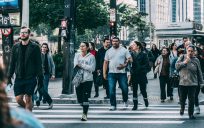Here’s what algorithms and the future of government could look like.
According to Merriam-Webster, an algorithm is defined as “a step-by-step procedure for solving a problem or accomplishing some end especially by a computer.”
 Algorithms are used almost every day, from Google’s search engine to taking a picture with your phone to focusing on someone’s face (as I’ve learned watching “The Secret Rules of Modern Living: Algorithms” on Netflix). Algorithms play an important part of our every day lives, and its use will continue to grow and expand. Algorithms are also used in a variety of government decisions.
Algorithms are used almost every day, from Google’s search engine to taking a picture with your phone to focusing on someone’s face (as I’ve learned watching “The Secret Rules of Modern Living: Algorithms” on Netflix). Algorithms play an important part of our every day lives, and its use will continue to grow and expand. Algorithms are also used in a variety of government decisions.
Algorithms have been used to help make decisions, but there needs to be more policies developed on managing the use of algorithms.
As I learn more about machine learning and algorithms in my graduate class, the uses are astounding. It can literally replace jobs. If implemented, it could replace four jobs at my classmate’s current company – policy and article tagging.
It can lead to a future that could actually be an episode of “Black Mirror” but instead is our reality. What struck me in our class discussion was that there are no clear and detailed policies in how to address the future implications of algorithms. Algorithms already are embedded in our lives so much, but they could get to the point where they replace most of our decisions or be used against the benefit of the public.
As we rely more on algorithms, we have to be aware of the potential for algorithmic bias. I’ve learned more about criminal justice algorithms (from watching “For the People” on ABC – which is great) and that can be used to predict the chances of a convicted criminal to commit another crime in the future. This algorithm takes a number of factors such as family, socioeconomic status and education levels to name a few of the variables that go into it. The algorithm was found to have been biased and treat certain convicted criminals unfairly when compared to other criminals who had similar backgrounds.
We also need to be cautious and ask for transparency with the use of algorithms. Just relying on the output of the algorithm rather than addressing the underlying criteria is not enough and could cause issues.
There seems to be a lack of oversight in how these algorithms are used and implemented in certain decision-making scenarios.
I think the most important thing we can do right now as regular citizens is educate ourselves on the basics of an algorithm and how it plays into our every day lives. There are some great documentaries on Netflix or resources on Google (both of which use algorithms too). On a greater level as well, more policies need to be developed on how to address algorithms’ implications on a variety of areas of our lives and to ensure safety and fairness for everyone.
For more reading on algorithms, check out these resources:
Building Transparency and Fairness into Public-Facing Algorithms
Analytics in Action: How Government Tackles Critical Issues with Data
Elaine Nghiem is part of the GovLoop Featured Contributor program, where we feature articles by government voices from all across the country (and world!). To see more Featured Contributor posts, click here.





Leave a Reply
You must be logged in to post a comment.